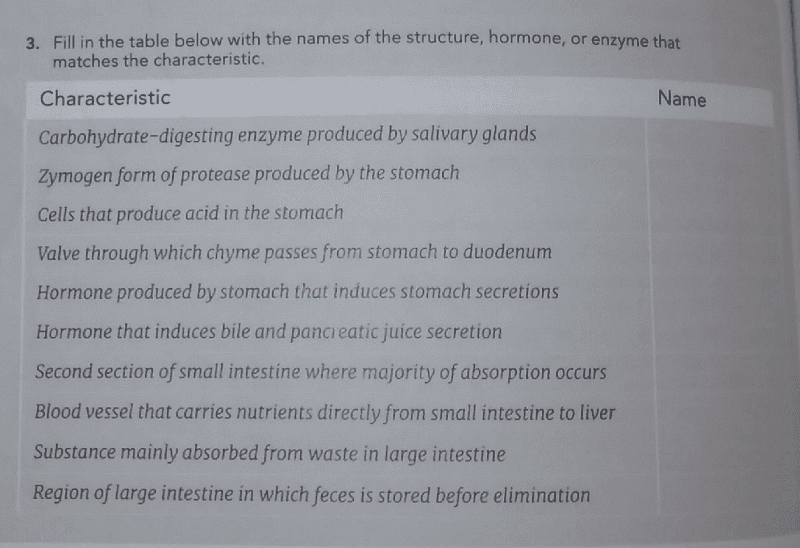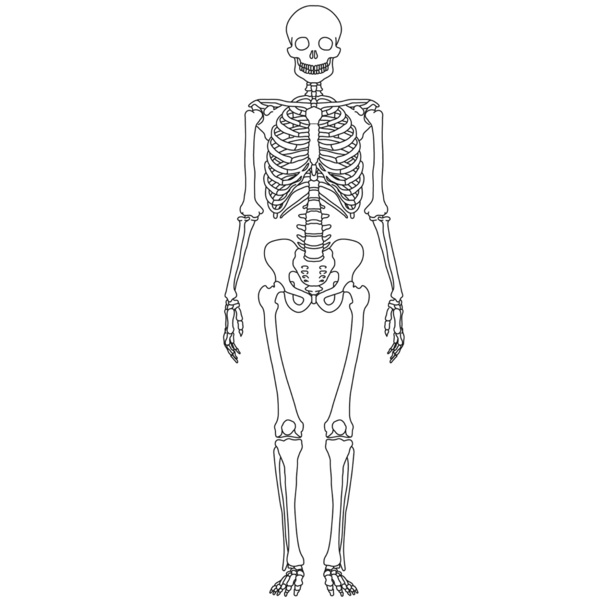Which of the following pairs correctly matches a cellular organelle with its function?
A. Golgi apparatus- protein synthesis
B. Smooth endoplasmic
reticulum- energy production
C. Cytoskeleton - movement
D.
Cell membrane- storage
C.
Which of the following describes an anatomical relationship between two structures in the human body?
A. The mouth is anterior to the nose.
B. The ribs are
lateral to the sternum.
C. The patella is inferior to the
tibia.
D. Muscles are superficial to skin.
B.
Which of these organs is directly involved in synthesis of red blood cells in an adult?
A. Liver
B. Spleen
C. Bone marrow
D. Lymph nodes
C.
At the end of a sprint, a runner breathes hard because the medulla oblongata senses which of the following?
A. Low oxygen levels in the blood
B. Low carbon dioxide
levels in the blood
C. Blood becoming more alkaline
D.
Blood becoming more acidic
D.
Which of the following situations would result in increased oxygen diffusion from alveoli into blood?
A. Increase in perfusion and decrease in ventilation
B.
Increase in oxygen concentration of blood
C. Reduction in
alveolar surface area
D. Reduction in residual volume of the lung
D.
Match the following respiratory system effects to their most probable cause.
A. Walking pneumonia 1. Coronavirus
B. Cystic Fibrosis 2.
Mycobacterium
C. Influenza 3. Gene Mutation
D. Tuberculosis
4. Fungus
E. Mycosis 5. Mycoplasmic infection
A. 5
B. 3
C. 1
D. 2
E. 4
Which of the following describes a property of cardiac cells?
A. Generation of electrical impulses
B. Production of red
blood cells
C. Immune protection functions
D. Removal of
waste products from the body
A.
Which of the following blood component levels would be expected to increase following vaccination?
A. Red blood cells
B. Antibodies
C. Dissolved
gasses
D. Leukocytes
B.
Which of the following statements regarding the circulatory system is correct?
A. The sinoatrial node is present in the top section of the right
atrium.
B. Veins returning to the heart carry deoxygenated
blood.
C. The heart's "lub-dub" sound is caused by
electrical impulse generation.
D. The heart's atria have thicker
walls than the ventricles.
A.
Which of the following physiological responses follows eating a large meal?
A. Pulse rate increases.
B. Peristalsis rate
increases.
C. Enzyme production decreases.
D.
Parasympathetic nervous activity decreases.
B.
Which of the following describes why liver failure is a critical health emergency?
A. The liver produces the majority of digestive enzymes.
B.
Food is filtered through the liver before digestion takes
place.
C. The liver helps digested food products to be pumped
around the body.
D. The liver filters digestion products and
produces urea as waste.
D.

Salivary amylase, Pepsinogen, Parietal cells, Pyloric sphincter, Gastrin, Cholecystokinin, Jejunum, Hepatic portal vein, Water, Rectum
Which of the following actions is controlled by the autonomic nervous system?
A. Walking
B. Chewing
C. Heart Beating
D. Talking
C.
Which of the following processes best describes how a signal travels across a nerve synapse?
A. Electrical
B. Kinetic
C. Potential
D. Chemical
D.
What is the primary component of muscles?
A. Fat
B. Protein
C. Carbohydrates
D. Nucleic Acid
B.
Which of the following organs produces sperm?
A. Penis
B. Testes
C. Prostate
D. Vas deferens
B.
Which of the following connects the ovaries and uterus?
A. Vagina
B. Cervix
C. Vas deferens
D. Fallopian tubes
D.
In which of the following organs is estrogen primarily made?
A. Testicles
B. Uterus
C. Scrotum
D. Ovaries
D.
Which of the following is the outermost layer of the skin?
A. Dermis
B. Sudoriferous
C. Sebaceous
D. Epidermis
D.
Which of the following is not excreted through the integumentary system?
A. Alcohol
B. Minerals
C. Blood
D. Urea
C.
Which of the following mechanisms is used when the body becomes too cold?
A. Blood vessel dilation
B. Sweating
C. Blood vessel constriction
D. Vitamin D production
C.
Which of the following describes the signal employed by the endocrine system?
A. Electrical
B. Chemical
C. Physical
D. Audio-visual
B.
Which of the following is not a gland in the endocrine system?
A. Pineal
B. Hypothalamus
C. Lung
D. Ovary
C.
Describe how a gland sends a message:
The gland synthesizes the hormone, which is released into the blood. The hormone then attaches to a receptor in or on the target gland or tissue to initiate a response.
Which of the following organs function as part of the genitourinary system to maintain blood pressure?
A. Heart
B. Kidney
C. Urinary bladder
D. Ureter
B.
Which of the following parts of the genitourinary system also transports sperm?
A. Kidney
B. Ureter
C. Urinary Bladder
D. Urethra
D.
Which of the following organs filters blood and creates urine?
A. Heart
B. Urinary bladder
C. Lungs
D. Kidney
D.
Which of the following are innate immune system cells that attack host cells harboring an intracellular pathogen?
A. Natural killer cells
B. Cytotoxic T-cells
C. Plasma Cells
D. Dendritic cells
A.
Which of the following is a nonspecific immune response?
A. Antibody secretion by plasma cells
B. Cytokine secretion by T-cells
C. Antigen recognition by B-cells
D. Cytokine-mediated inflammation
D.
Which terms are innate or adaptive immune system components.
A. Leukocytes, Monocytes, Dendric cells, NK cells, Complement, Inflammation, Phagocytosis, Toll-like receptors, Interferons, PAMPs, Antimicrobial proteins, Physical barriers, Chemical secretions, Lysoyme
B. Lymphocytes, B-cells, Cytotoxic T-cells, Plasma cells, Memory cells, Antibodies, Helper T-Cells
A. Innate:Leukocytes, Monocytes, Dendric cells, NK cells, Complement, Inflammation, Phagocytosis, Toll-like receptors, Interferons, PAMPs, Antimicrobial proteins, Physical barriers, Chemical secretions, Lysoyme
B. Adaptive Immune System: Lymphocytes, B-cells, Cytotoxic T-cells, Plasma cells, Memory cells, Antibodies, Helper T-Cells
Which of the following cells is involved in mineral resorption from bone?
A. Osteoclasts
B. Osteoblasts
C. Canaliculi
D. Osteon
A.
Which of the following bones articulate at a synovial joint?
A. Skull bones
B. Radius and ulna
C. Bones of the pubis
D. Humerus and scapula
D.
Label the bones of a skeleton.
